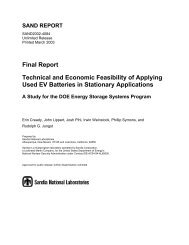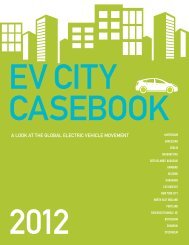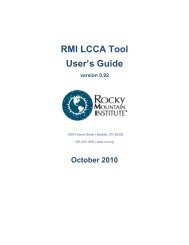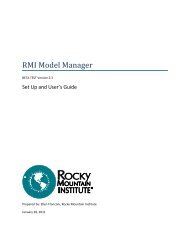Fleet Electrification Roadmap
Fleet Electrification Roadmap
Fleet Electrification Roadmap
- No tags were found...
Create successful ePaper yourself
Turn your PDF publications into a flip-book with our unique Google optimized e-Paper software.
134 part four: policy recommendations other policiesfleet electrification roadmap 135CHAPTER 4.2Other Policies<strong>Fleet</strong> microsystems represent an important opportunity to accelerate adoptionof GEVs among commercial and government fleet operators. Additional policiesbeneficial to the broader market could help to reduce the risk of batterypurchases and help accelerate technological development.Policy RecommendationReinstate and extend the tax credit formedium- and heavy-duty gasolinehybrid electric vehicles that utilizeadvanced batteries with energy andpower density equal to or greaterthan lithium-ion batteries.HEVs are well suited for use by fleets that engage in urbanstop and go driving, because such vehicles lose substantialenergy as heat in the braking process that can be captured,stored, and reused. Delivery vehicles, public transportvehicles and other heavy vehicles that drive regular urbanroutes are prime candidates for hybridization, and today’scosts for HEV in these sectors could provide near-termopportunities for adoption. Hybrid vehicles can not onlyachieve substantial saving of fuel, but also reduce tailpipeemissions of nitrous oxide, particulate matter, and carbondioxide, each an important benefit in their own right. Yet,from the <strong>Electrification</strong> Coalition’s perspective, what maybe most attractive about these vehicles is their abilityto expand the size of the market for lithium-ion batterycells, large-format batteries, and their component parts.FIGURE 4AExpired Credit for Demonstrated Fuel Economy GainsIncreased deployment of HEVs represents an opportunityfor increases in scale that can reduce costs for all largeformatautomotive-grade batteries.In 2005, Congress established a tax credit for thepurchase of medium- and heavy-duty hybrid electricvehicles. The tax credit was worth between 20 and 40percent of the incremental cost of a hybrid vehicle subjectto limits based on the vehicle’s efficiency. The tax creditexpired, however, at the end of 2009.In 2010, legislation was introduced that would extendand expand the tax credit, but it did not pass. The EC believesthat medium- and heavy- duty hybrid vehicles, many ofwhich serve in fleets, can substantially promote the deploymentof all GEVs by adding scale to battery production,thereby reducing battery costs for all vehicles. Therefore,the tax credit that expired at the end of 2009 should beextended and expanded generally consistent with the provisionsof S. 2854, introduced by Senators Herb Kohl (D-WI)and Orrin Hatch(R-UT), which would extend it through theend of 2014 and expand the size of the tax credit available tomedium- and heavy- duty hybrid trucks subject to the limitsstated in the table below. Consistent with its purpose of promotingscale production of batteries for use in all vehicles,availability of the credit should be limited to vehicles thatutilize advanced batteries with energy and power densityequal to or greater than lithium-ion batteries.VEHICLE WEIGHT MAX FOR 30% FE INCREASE MAX FOR 40% FE INCREASE MAX FOR 50% FE INCREASE8,501-14,000 lbs $1,500 $2,250 $3,00014,001–26,000 lbs $3,000 $4,500 $6,000FIGURE 4BProposed Maximum Credit Available for Demonstrated Fuel Economy GainsVEHICLE WEIGHT 20% GAIN 30% GAIN 40% GAIN 50% GAIN8,500-14,000 lbs n/a $3,000 $4,500 $6,00014,001–26,000 lbs n/a $3,000 $9,000 $12,00026,001–33,000 lbs n/a $12,000 $18,000 $24,000> 33,000 lbs $10,000 $20,000 $24,000 $24,000Policy RecommendationEstablish a program to guarantee theresidual value of the first generation oflarge-format automotive batteries putinto service between 2010 and 2013.The battery frequently is the most expensive componentin a PHEV or EV. Even when a battery is no longer capableof storing a sufficient charge to support the operation of avehicle with adequate power and range, it likely will stillhave ample life to serve in other capacities where energydensity and weight are not as important as in vehicles,such as firming up intermittent power, serving as a sourceof emergency backup power, or as a source of distributedgeneration. Therefore, a “used” vehicle battery will stillhave value that the consumer can capture at the timeof vehicle or battery disposal, and which can serve as anadditional incentive at the time of purchase.There is, however, a sequencing problem that makesit difficult to understand the value of the “used” battery,and which makes it likely to underestimate its value: amarket for secondary uses of automotive-grade batteriescannot develop until there are used batteries, butthere will not be a large supply of used batteries for severalyears. It is, therefore, difficult for the non-expert, inparticular, to estimate the residual value of the battery ina newly purchased vehicle. By immediately guaranteeingthe residual value of used batteries at between 60and 80 percent of their expected value, the governmentwould effectively be offering an incentive to purchasers ofPHEVs and EVs while likely costing the government littleif anything.The Department of Energy should establish a programthrough which purchasers of vehicles with largeformatautomotive-grade batteries will be guaranteeda minimum residual value of their battery for a definedperiod of time after the purchase of the vehicle that shallinclude the following provisions:1. The guarantee applies only to a battery purchasedin a new vehicle, and the battery mustremain in the vehicle until the sale that triggersthe guarantee, but is transferable to subsequentowners of the vehicle.2. The guarantee equals $50 per kWh of nameplatecapacity for a period of one year afterthe expiration of its warranty. The guaranteedeclines by 50 percent until the end of thesecond year after the expiration of its warranty,after which it is no longer available.3. For the guarantee to be available, the batterymust have been covered by a warranty for atleast two years and must be intact, but neednot be working. In other words, the guaranteewill not pay for damaged batteries, such asthose damaged in accidents.4. The guarantee will be available to certified purchasersof batteries. If the value of the batteryis less than the guaranteed minimum residualvalue, the Department of Energy will pay certifiedbattery purchasers the difference betweenthe guaranteed residual value and the marketprice the battery. That will allow the certifiedpurchaser to purchase the battery from a vehicle/batteryowner at the guaranteed minimumresidual value.5. Any entity may seek certification by theDepartment of Energy as a participant in theprogram.> 26,000 lbs $6,000 $9,000 $12,000
















